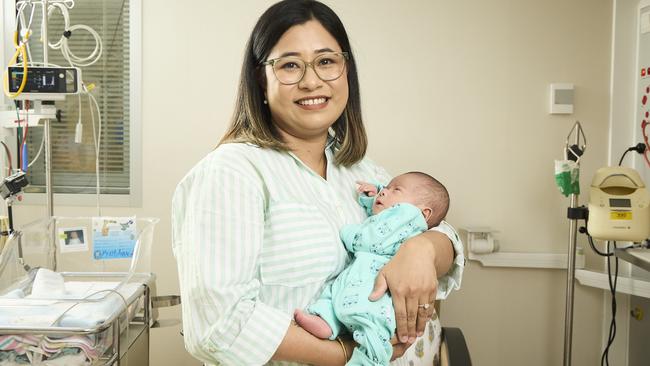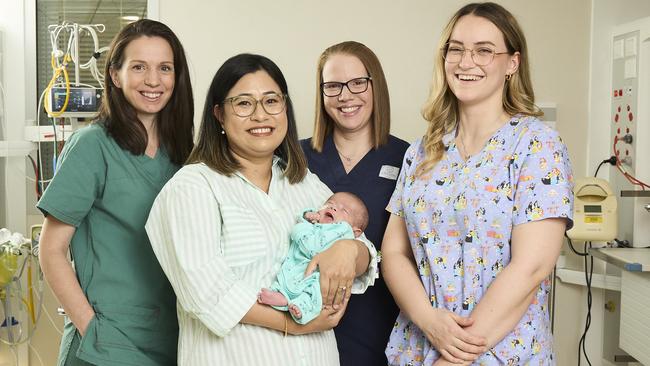Inside FMC’s Neonatal Unit, where premature babies’ lives are saved every day
For SA’s tiniest patients, seconds can mean the difference between life and death. Meet the heroes making sure these little ones make it home.
SA Weekend
Don't miss out on the headlines from SA Weekend. Followed categories will be added to My News.
When the elevator doors open to level three of Flinders Medical Centre, the usual chaos, intensity and thick air of hospital unease falls away.
Instead, artworks scrawled by tiny hands and posters – with quotes from Harry Potter, Bluey and Winnie the Pooh – line the walls. Despite the bustling urgency of nurses and doctors, there’s a sense of home.
This is the Neonatal Unit, where everyday heroes put the needs of SA’s tiniest patients and families centre stage.
Inside its tangled hallways are 50 cots, family rooms, overnight accommodation for families and intensive care facilities.
At each turn, monitors beep with the sound of tiny heartbeats.

FMC is currently the only hospital in South Australia and the Northern Territory capable of providing healthcare for critically ill pregnant women and sick or preterm infants, and just one of two neonatal intensive care units in SA.
Each year, more than 1400 babies are admitted to the Neonatal Unit, with about 250 – some born as young as 23 weeks’ gestation – requiring intensive care.
There are 16 intensive care beds, including four beds set up for isolation to allow babies with a potentially contagious infection to be treated without endangering other infants, to care for the state’s most critically ill newborns.
Since opening 42 years ago, the unit has saved the lives of tens of thousands of sick term and premature babies, improved the survival rates for the youngest born (23 weeks) from 10 per cent to 70 per cent, slashed neonatal stays, markedly improved long-term health outcomes, and stretched a baby’s viable birth gestation from 28 weeks to 23 weeks.
Prabhav Rajbhandari is one of the unit’s charges.
Born at just 26 weeks, he is about to celebrate his 100th day since birth – a milestone his mother, Bhawana, almost didn’t think would come.

While little Prabhav sleeps in his closely-monitored cot, Bhawana clutches a kaleidoscope-coloured string of beads almost a metre long.
Known as Stella Bella beads, each bead on the treasured string represents a milestone moment in Prabhav’s journey.
Tiny porcelain pandas and lions are among those marking good days, bad days and “brave days”.
Bhawana’s choked sobs betray the depth of her gratitude.
“I can’t believe that I’m holding my baby in my arms right now,” she says.
“They’ve become our family – they’ve supported us, looked after us physically and mentally. It’s a second home now.”
When the time comes, Prabhav will get a hero’s farewell through the halls. Each baby’s last day in hospital is marked by a victory lap of the unit – each nurse and doctor applauding in a joyous goodbye.
Among that team is consultant neonatologist Dr Kathryn Martinello, whose tiny baby bump is just visible through her dark green hospital scrubs.
Every day, Martinello deals with what are known as “high acuity” cases: sometimes mere moments between life and death.
“Sometimes you are rushing to save a baby who is very, very sick, or rushing to attend a delivery of a baby who was born not breathing or needs extra help,” she says.
“To see them make it through is really rewarding and satisfying.”
With some babies – like Prabhav – spending upwards of three months in the unit, Martinello says families can become friends.
“We get to know them, so seeing them go home after 100-plus days in the unit is really, really lovely,” she says.
“We are lucky as doctors to get them to come back to see us in clinic, so we get to check in with them regularly as they achieve their milestones.”
But not every story has a happy ending.

Martinello’s professionalism takes over when asked about the tough days in the unit, but a glimpse of heartache slips through.
The other nurses in the room, unit manager Sarah Wauchope and nurse Rebekah Blacket, lean towards their colleague – a silent display that hints at the closeness of the team.
“We obviously have difficult days where things don’t go as we would like them to. Some babies don’t make it home,” Martinello says.
“But we support each other. We debrief on the babies and think about the care that we provided and whether we could have done anything differently or improve for next time.
“We look after each other.”
Neonatal nurse Blacket, 27, had never held a newborn before requesting to work in the neonatal unit during her graduate year.
“It was a daunting experience, a very steep learning curve, but everyone was so supportive,” she says.
“It’s such an important job and such a privilege to look after someone’s baby when they’re not able to.”
Now, cradling tiny Prabhav in her arms, she says the weight of her responsibility is never forgotten.
“Some of the time, when the parents can’t be at their baby’s bedside – at 2am or 3am – and you just get to sit there peacefully, cuddling a sleeping baby … that’s one of the best moments in the world.”





